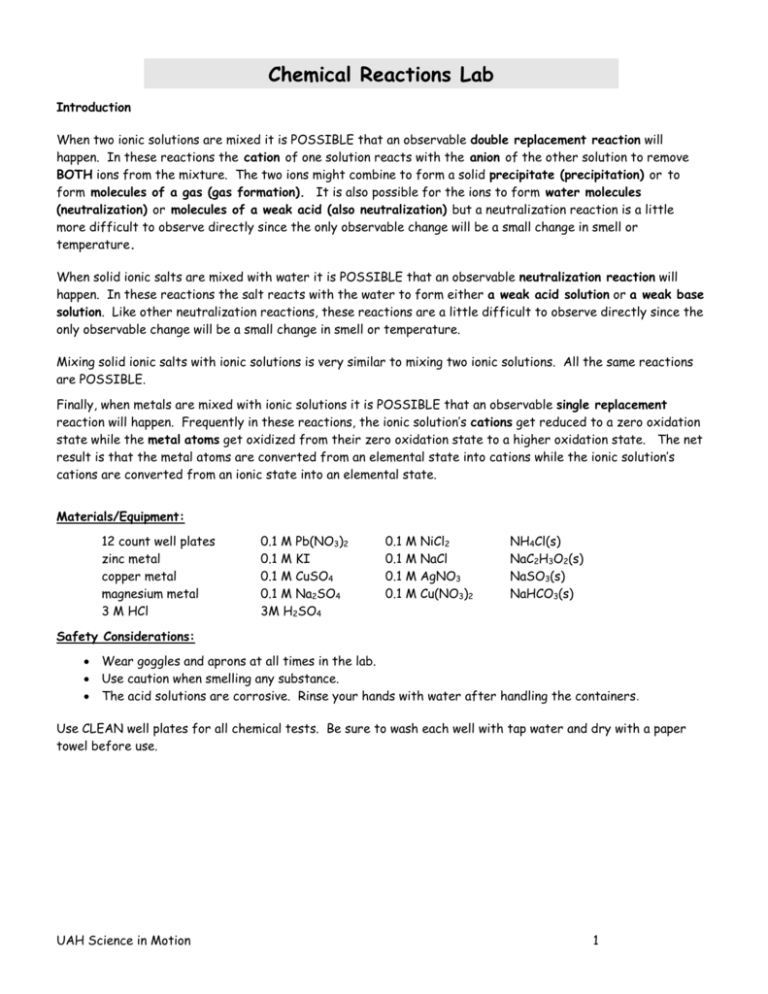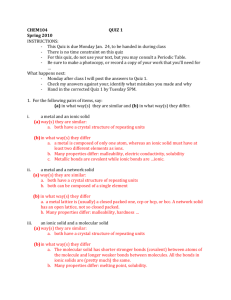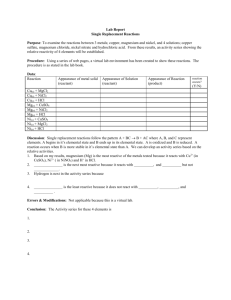Graphical Analysis
advertisement

Chemical Reactions Lab Introduction When two ionic solutions are mixed it is POSSIBLE that an observable double replacement reaction will happen. In these reactions the cation of one solution reacts with the anion of the other solution to remove BOTH ions from the mixture. The two ions might combine to form a solid precipitate (precipitation) or to form molecules of a gas (gas formation). It is also possible for the ions to form water molecules (neutralization) or molecules of a weak acid (also neutralization) but a neutralization reaction is a little more difficult to observe directly since the only observable change will be a small change in smell or temperature. When solid ionic salts are mixed with water it is POSSIBLE that an observable neutralization reaction will happen. In these reactions the salt reacts with the water to form either a weak acid solution or a weak base solution. Like other neutralization reactions, these reactions are a little difficult to observe directly since the only observable change will be a small change in smell or temperature. Mixing solid ionic salts with ionic solutions is very similar to mixing two ionic solutions. All the same reactions are POSSIBLE. Finally, when metals are mixed with ionic solutions it is POSSIBLE that an observable single replacement reaction will happen. Frequently in these reactions, the ionic solution’s cations get reduced to a zero oxidation state while the metal atoms get oxidized from their zero oxidation state to a higher oxidation state. The net result is that the metal atoms are converted from an elemental state into cations while the ionic solution’s cations are converted from an ionic state into an elemental state. Materials/Equipment: 12 count well plates zinc metal copper metal magnesium metal 3 M HCl 0.1 M Pb(NO3)2 0.1 M KI 0.1 M CuSO4 0.1 M Na2SO4 3M H2SO4 0.1 M NiCl2 0.1 M NaCl 0.1 M AgNO3 0.1 M Cu(NO3)2 NH4Cl(s) NaC2H3O2(s) NaSO3(s) NaHCO3(s) Safety Considerations: Wear goggles and aprons at all times in the lab. Use caution when smelling any substance. The acid solutions are corrosive. Rinse your hands with water after handling the containers. Use CLEAN well plates for all chemical tests. Be sure to wash each well with tap water and dry with a paper towel before use. UAH Science in Motion 1 Procedure Record the following observations for each reaction: SIGHT - Look for the presence of a solid precipitate either as a solid in the bottom of the well or as cloudiness in the solution. Note that a color change alone does not indicate the formation of a precipitate. If a solid metal changes color at its surface (particularly to black), this generally indicates the precipitation of another metal on the surface. You should also look for the formation of bubbles since this indicates a gaseous product has formed. TOUCH - Touch the bottom of each well to note any temperature change that may occur. ODOR - Sometimes a chemical reaction produces a product with a distinct odor. These are usually gases, although many gases have no odor. To detect an odor, waft the vapors by holding the well plate in one hand and waving the other hand above the top of the well plate towards your nose. Perform this carefully; some vapors are irritating. Be sure the odor is due to the product, not a reactant! Part 1: Mixing of Ionic Solutions: Mix about 15 drops of each of the solutions specified. 1. 2. 3. 4. 0.1 M Pb(NO3)2 with 0.1 M KI 0.1 M NiCl2 with 0.1 M NaCl 0.1 M CuSO4 with 0.1 M Na2SO4 0.1 M AgNO3 with 0.1 M NaCl Record your observations now. Part 2: Mixing of Solid Salts and Water: Mix a small scoop of each solid with about 15 drops of water. 5. solid NH4Cl with water 6. solid NaC2H3O2 with water Record your observations now. Part 3: Mixing of Solid Salts with Ionic Solutions. Mix a small scoop of each solid with about 15 drops of the solution specified. 7. solid NaC2H3O2 with 3M sulfuric acid 8. solid Na2SO3 with 3M hydrochloric acid 9. solid NaHCO3 with 3M hydrochloric acid Record your observations now. Part 4: Mixing of Metals and Ionic Solutions: Mix a small sample of each metal with 15 drops of the solution specified. 10. 11. 12. 13. zinc metal with 0.1 M Cu(NO3)2 zinc metal with 3M HCl copper metal with 3M HCl magnesium metal with 3M HCl Record your observations now. UAH Science in Motion 2 Name _________________________ Observation Record Mix Sight Touch Smell 1 2 3 4 5 6 7 8 9 10 11 12 13 UAH Science in Motion 3 Name _________________________ Writing reaction equations: For each mixture write an ionic equation and a net ionic equation. If no reaction was observed, write “no reaction.” Mix Ionic Net Ionic 1 2 3 4 5 6 7 8 9 10 11 12 13 UAH Science in Motion 4 Name _________________________ Pre-Lab Exercise Predictions: Predict what will happen when the following reagents are mixed together. You may use any of the following sources to help you: A list of solubility rules, A solubility table, A chemical activity series, A table of weak acids and/or bases Reagents Prediction Pb(NO3)2 (aq) and KI (aq) NiCl2 (aq) and NaCl (aq) CuSO4 (aq) and Na2SO4 (aq) AgNO3 (aq) and NaCl (aq) NH4Cl (s) and water NaC2H3O2 (s) and water NaC2H3O2 (s) and H2SO4 (aq) Na2SO3 (s) and HCl (aq) NaHCO3 (s) and HCl (aq) Zn metal and Cu(NO3)2 (aq) Zn metal and HCl (aq) Cu metal and HCl (aq) Mg metal and HCl (aq) UAH Science in Motion 5






